about us
Owner’s Greeting
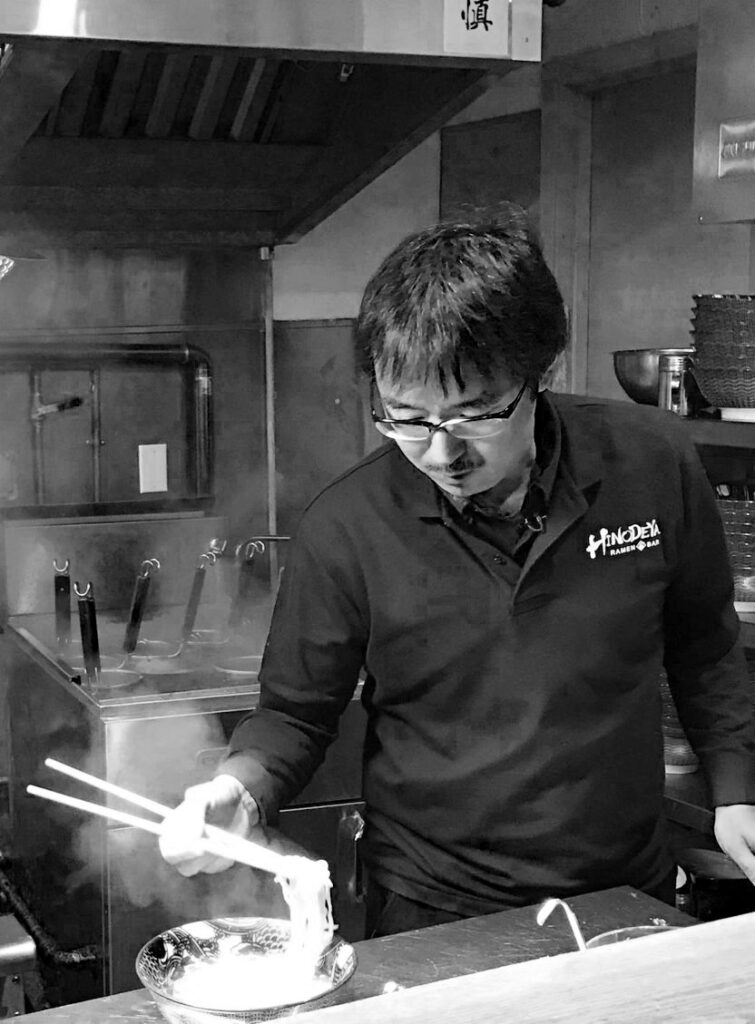
Tastier, More exciting, and More comfortable!
It is the greatest pleasure for us to see you smile while you are dining and to have you feel that the time you have spent at Sasala Group is a satisfying experience.
The history of Sasala dates back to Hinode-ya, a small dining place established in 1885. We have inherited a tradition of over 130 years of discipline and confidence since then; we are now aiming to create restaurants with a commitment to optimum quality, which can provide you with delicious dishes of selected ingredients, a good stock of sake, beautiful tableware, Japanese space-designing, cozy room-lighting, and BGM. We’re sure you will enjoy a prosperous time at our places using your “five senses.”
We have been actively introducing new food materials and original ways of cooking based on the principles of traditional Japanese cuisine so that you will be thrilled with our modern Japanese dishes. We are also seeking such Japanese dishes honestly as a break away from old styles but preserving good elements of conventional foods.
“More tasty, More exciting, and More comfortable” is our mantra to make your visit to Sasala a pleasurable experience. It gives us the most pleasure to see our customers smiling while
To go a step further, every staff member of Sasala Group works hard every day.
We are looking forward to welcoming you to Sasala.
Owner’s Profile
Masao, KURIBARA CEO of the Sasala Dining inc.
He was born in Hasuda city, Saitama prefecture, Japan.
After he graduated from the Culinary Institute in Osaka, he worked for the prestigious Japanese restaurant called Kicchou(吉兆) in Ginza, Tokyo. When he was 27, he was given the head chef position at the Japanese embassy in Holland. During his tenure there, he served many visiting dignitaries with the then Prime Minister, Ryutaro Hashimoto, and former President of the States Bill Clinton, partaking in his Japanese culinary creations.
After returning to Japan, he began work for the Imperial Hotel. Later, he took charge of a notable luxury establishment, working as manager of its Japanese restaurant. He was a founding member of starting that restaurant’s first move abroad, to Saipan.
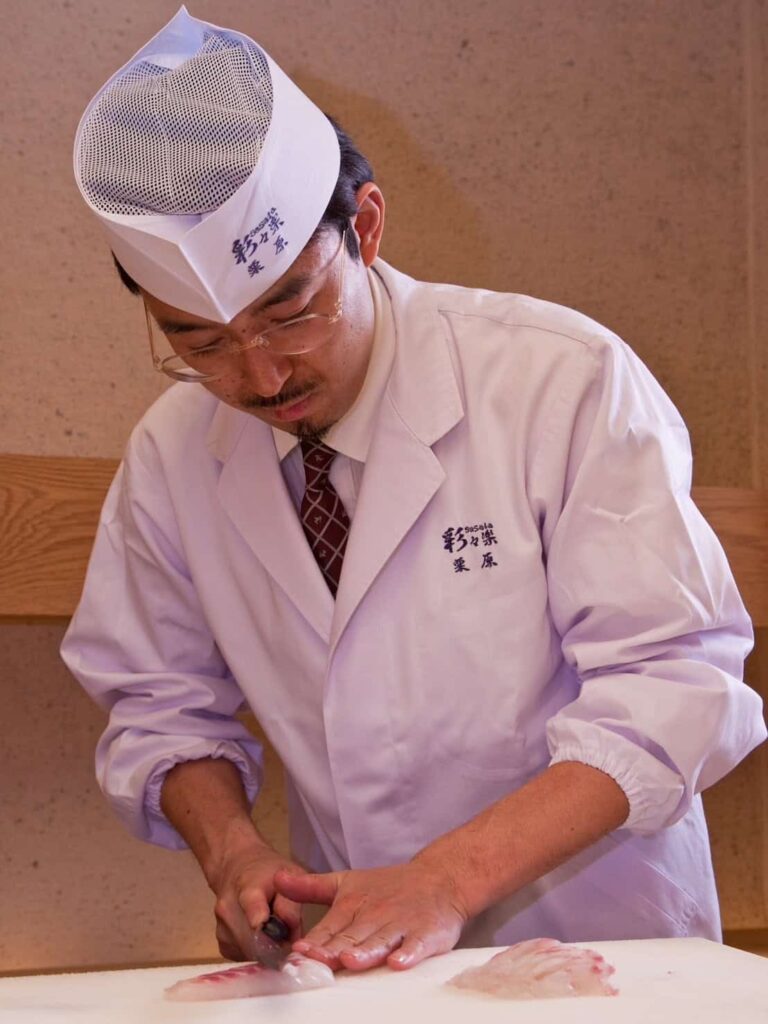
From this overseas working experience, he could understand Japan’s appeal objectively and found that Japanese cuisine was recognized as a world-class culture. He started to think of his position as a chef who could spread Japan’s appeal to the world through food. Therefore, he put efforts to keep his restaurant in Japan on track to start with the eventual goal of opening a branch in the United States, pursuing that dream for his ten years running the Sasala Group.
The first restaurant, Sasala, and the second restaurant, Sora, were awarded the first prize in the competition held by the California wine Institute in 2008 and 2012. They have received an award from the American Embassy as well. In addition, the third ramen shop was chosen as the best Ramen shop in Saitama prefecture by one of the famous buzz marketing sites in 2014, and there is always a long queue in front of the shop. And last year, the newly opened 4th restaurant called TORAYA, a traditional Japanese BBQ-themed izakaya, was off to a strong start.
In thinking of an overseas expansion, he considered target countries by visiting many capital cities from Asia to North America but finally launching his 5th restaurant in North America. After two trips to the on-site inspections, it was decided California State, Northern California in San Francisco was the ideal site. The local subsidiary SASALA DINING USA Inc. was founded in October 2015.
Among his personal qualifications, Masao is a minister-certified chef of Japanese cuisine with multiple certifications in numerous gourmet dishes. He holds the qualifications to teach the preparation of Japanese food in a professional setting as well. He is a member of the Japan Sommelier Association and an FBO-certified Japanese rice wine (both sake & shochu) specialist. In addition to his position as manager of head chef of the Sasala restaurants, he has been invited as a guest lecturer for events. He sits as the chairman of NeoLotus, a collective of local fine dining establishments in his hometown area. His level of expertise and experience in both the kitchen and management places him among the top chefs in the greater Tokyo area.
Career
- Tokyo Kitcho Ltd. (workplace: Hotel Western Ginza and Imperial Hotel)
- Embassy of Japan in the Netherlands, Chief cook for ambassador’s residence
- Imperial Hotel Ltd. (workplace: The Hotel Grand Arc Hanzo-mon)
- Manager chef of Japanese cuisine Hatsu in Mita, Minato Ward, Tokyo
- Opening manager of UBU SAIPAN, Garapan, on Saipan, the United States
- CEO of Sasala Group
- President of Neo-Lotus, a grouping of restaurant owners in Hasuda
Qualifications and licenses
- Licensed Cook based on Licensed Cooks Act
- Food Hygiene Manager based on Food Sanitation Act
- Certificate for teaching at culinary vocational schools
- Certificate of Sommelier administered by Japan Sommelier Association
- Sake Instructor certified by Food & Beverage Specialists Organization (FBO)
- Kikizake-shi [Sake Sommelier] certified by Sake Service Institute (SSI)
- Shyochyu Kikizake-shi is certified by Sake Service Institute (SSI)
- Food and Beverage Navigator certified by Food & Beverage Specialists Organization (FBO)
- Comrade of Cheese certified by Cheese-Professional Association (CPA)
- Licensed Cook of Fugu [globefish/blowfish] by the Governor of Tokyo Metropolis and those of Kanagawa, Saitama, Osaka, and other Prefectures
history

The newly-opened Hasuda Station

Tome Kuribara, founder’s wife and manager/chef
In 1885 Hinode-ya was founded.
In 1885, when a new train line was constructed between Omiya and Utsunomiya, Hasuda Station was opened on the eastern part of Saitama Prefecture. Soon afterward, Kanjiro Kuribara and his wife Tome founded a small dining place officially named Hinode-ya (literally Sunrise-house) in front of the west exit of Hasuda Station.
The eating place had about 15 seats and served Tome meals chiefly using homegrown vegetables and rice. Their customers were a small number of travelers getting on and off the trains that ran only twice a day in each direction and shipping workers and porters working there.
In 1919 Kintaro Kuribara succeeded his father as the second-generation owner/manager of Hinode-ya.
In 1919, the founder Kanjiro passed away, and Kintaro Kuribara took over the family business. Kintaro engaged himself mostly in growing crops necessary for Hinode-ya and selling the rest while supporting the operation of the eating place when required. His wife Ine managed the shop virtually by herself. The couple worked together to run Hinode-ya as their parents did.
Kintaro had a good head for business. He gradually expanded his farmland, developed new markets, and succeeded as an agricultural businessman. The frontage of Hinode-ya, which was initially about 3.6 meters wide with an earthen-floored space in the front, was expanded. In 1949, the building was entirely rebuilt into a two-story restaurant with tatami rooms upstairs. They started serving alcoholic drinks like sake and Japanese noodle soba or buckwheat noodle. Business hours were extended till well after evening meals.

In 1921, Kintaro Kuribara on military service for Manchuria (front middle, at age 26)
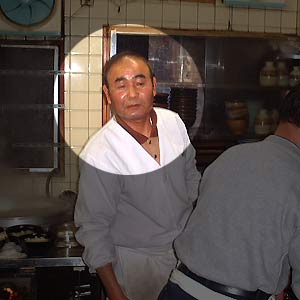
Kenya Kuribara, the third-generation owner/chef

Front view of Hinode-ya after a complete renovation
In 1949 Kintaro’s son Kenya Kuribara succeeded his father as the third-generation owner/chef of Hinode-ya.
After Kenya started to manage Hinode-ya, he added Western and Chinese dishes many times to the menu based mainly on traditional Japanese food like soba. Kenya was honest and liked to keep things amazingly clean and tidy. His restaurant gradually became more and more popular in the city, and in 1960, Kenya incorporated his business as a private limited company, “Hinode-ya Ltd., Co.” Starting a meal delivery service, Kenya hired several employees for the first time, and Hinode-ya was becoming more prosperous. When the building was fully renovated in 1983, the number of seats was increased to 42, about three times the number of 15 at the time of its foundation in 1885.
In 2005 Relocation owing to the regional redevelopment in front of the west exit of Hasuda Station.
After the turn of the century, the age of change came. The building of Hinode-ya, which had been standing at the place of foundation for 120 years, had to be demolished and relocated to a nearby location, the present site. Later in the same year, a new, modern building began to be constructed there.

Old Hinode-ya is being demolished.

Sasala (New Hinode-ya) being constructed
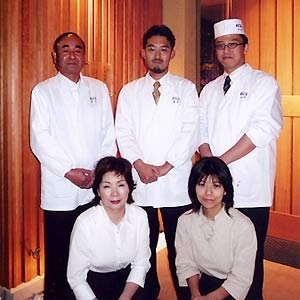
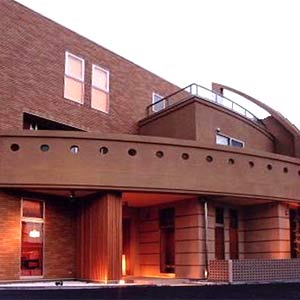
The newly-built Sasala
In 2006 a new building was completed. Masao Kuribara succeeded his father, Kenya as the fourth-generation owner/chef of Hinode-ya.
When the new building was completed, Masao Kuribara came back to his hometown of Hasuda and took over the family business as the fourth-generation manager/chef of Hinode-ya. He decided to change the official name Hinode-ya to Sasala and also the legal name of the company from “Hinode-ya Co., Ltd.” to “Sasala Co., Ltd..” The younger chef Masao took advantage of his career and experiences, and his challenge started with a high-class Japanese restaurant named Sasala, breaking away from Hinode-ya.
The third and the fourth generation owner/chefs and staff members at Sasala (back from left, Kenya Kuribara, Masao Kuribara, chief cook Matsumura; front from left, Keiko Kuribara (chief manager), Kumiko Kuribara (manager)
In 2008, Sasala won the First Prize in California by Glass Promotion 2008
Two years after its opening, the Japanese Restaurant Sasala won the first prize in a contest called California by Glass Promotion 2008, sponsored by California Wine Institute, which represents more than 1,000 wineries in California. Owing to the award, many magazines and papers have carried articles featuring Sasala.

An article about winning the first prize
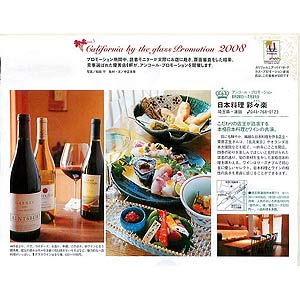
Award Ceremony in 2008
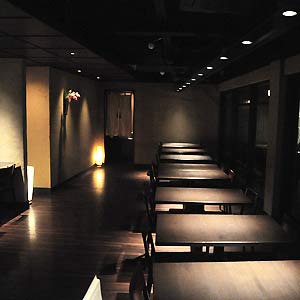
In 2010 Second dining place of Sasala Group, SOBA DINING SORA opened.
Four years after the opening of the Japanese restaurant Sasala, we opened a second eating place named Soba Dining Sora (蕎麦ダイニング空楽) right in front of the west exit of Hasuda Station near Sasala. This casual dining place features handmade buckwheat noodle soba and deep-fried meat and vegetables on skewers. The Chinese character “空,” (pronounced sora) means “sky” or “air,” the latter half of the sound “ra” being part of the word “楽,” (pronounced raku) meaning “enjoy.” Thus CEO/chef Masao Kuribara decided to adopt “空楽” (pronounced sora) as the name of the second shop because he would like you to enjoy not only the dishes served but also the relaxed atmosphere and the time you experience at this place. Sora was also given the first prize in California by Glass Promotion 2012, sponsored by California Wine Institute.
In 2012 Third dining place of Sasala Group, WAFU-RAMEN, the Fourth Generation HINODEYA, opened.
Six years after the opening of Sasala, we opened a third eating place named Wafu-Ramen the Fourth Generation Hinodeya (和風ラーメン四代目ひのでや) beside Sora. This ramen shop specializes in serving ramen, the main item for which the previous Hinode-ya was famous. CEO/chef Masao Kuribara wanted to revive the lost name of Hinode-ya since the name had disappeared when the old building was demolished.
Hinodeya’s new wafu-ramen, which took in the skills of wa-shoku or traditional Japanese cooking for the first time, became the focus of attention in the ramen industry because it defied basic common sense in cooking ramen. Wafu-Ramen Hinodeya won the first prize in the online contest of Saitama Best Ramen 2014 conducted through Tabelog, the biggest database of restaurants in Japan providing original rankings based on reviews from users. Again in 2016, it was chosen out of 38,000 ramen noodle shops in Japan as one of the final nominees in the north Tokyo area for the Tabelog Japan Ramen Award 2016 conducted by the same research company. Wafu-Ramen the Fourth Generation Hinodeya has been highly evaluated by other researchers or organizations and featured in a lot of magazines and newspapers.
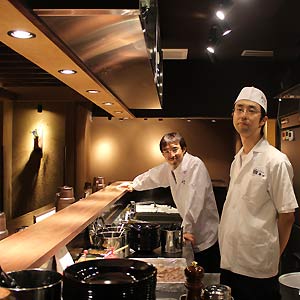
Owner / chef Masao Kuribara and store manager in Wafu-Ramen Hinodeya

Robata Sumiyaki Toraya Inner view of Toraya : Edison light bulbs hung around over robata sumiyaki kitchen

Robata Sumiyaki Toraya Inner view of Toraya: dining room and low tables with foot space for easy sitting
In 2015 Fourth dining place of Sasala Group, ROBATA SUMIYAKI TORAYA, opened.
In 2015, nine years after the opening of Sasala, we opened a fourth eating place named Robata Sumiyaki Toraya (炉端炭焼・灯楽家) in front of the east exit of Hasuda Station. This Japanese bar/tavern was designed with the idea of eating popular Japanese meals in a relaxed mood and drinking sake. Since the interior is decorated with recycled old wood taken out from houses over 100 years old, using nostalgic Edison electric light bulbs as lighting apparatus, Toraya induces you to imagine how sitting in the old Hinode-ya would feel, which was established back in 1885.
In 2016 Wafu-Ramen Shop HINODEYA opened in San Francisco.
In years after the opening of Sasala, the center of Sasala Group, we opened our fifth dining place Wafu-Ramen [Japanese Ramen], the Fourth Generation Hinodeya in San Francisco. This is our first shop outside Japan in our long history.
Address: 1737 Buchanan Street San Francisco, CA 94115, USA
Call: 415-216-5011
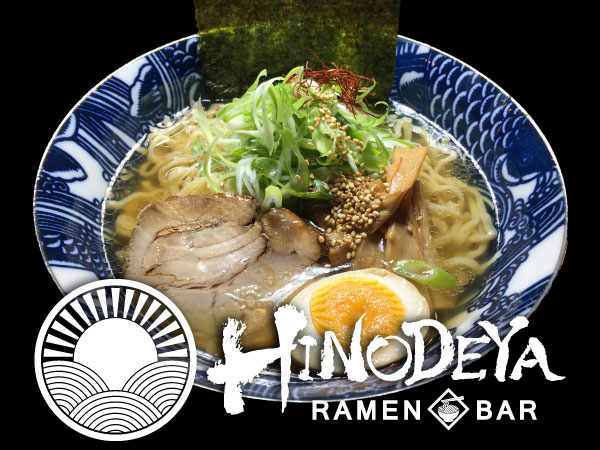
Owner / chef Masao Kuribara and store manager in Wafu-Ramen Hinodeya
Group Shop
Japanese Restaurant SASALA
- Our main dining place has inherited a long tradition of honesty over a century from Hinode-ya.
- Lorem ipsum dolor sit amet, consectetur adipisicing
- 000-000-0000
Soba Dining SORA
- Lorem ipsum dolor sit amet, consectetur adipisicing
- 000-000-0000
Wafu-Ramen YONDAIME HINODEYA
- Our third dining place which has inherited the brand name Hinode-ya founded in 1885, and specializes in wafu-ramen, or Japanese Chinese noodles.
- Lorem ipsum dolor sit amet, consectetur adipisicing
- 000-000-0000
